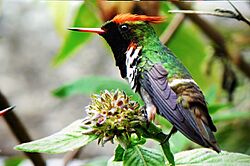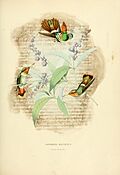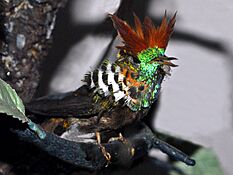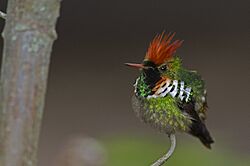Frilled coquette facts for kids
Quick facts for kids Frilled coquette |
|
|---|---|
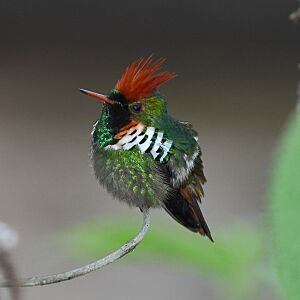 |
|
| A frilled coquette male at Itatiaia National Park, Rio de Janeiro state, Brazil | |
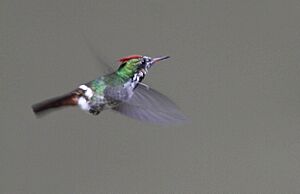 |
|
| Lophornis magnificus caught in flight | |
| Conservation status | |
| Scientific classification | |
| Genus: |
Lophornis
|
| Species: |
magnificus
|
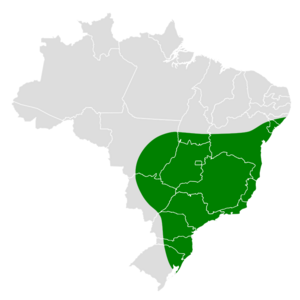 |
|
The frilled coquette (Lophornis magnificus) is a tiny and beautiful hummingbird that lives only in Brazil. It's known for its amazing looks, especially the male's fancy feathers.
Contents
About the Frilled Coquette
The name "Lophornis" comes from ancient Greek words. "Lophos" means "crest" or "tuft," and "ornis" means "bird." This describes the male's special head feathers. The word "magnificus" is Latin for "magnificent" or "splendid," which perfectly fits this stunning bird.
The frilled coquette is a unique bird and is the only species in its group, meaning it doesn't have any close relatives that are also called "frilled coquettes."
What Does It Look Like?
The frilled coquette is one of the smallest birds on Earth! It's only about 7 to 7.7 centimeters (about 3 inches) long. It weighs around 2.66 grams, which is less than a penny!
Both male and female frilled coquettes have a short, straight bill that is red with a black tip. Their upper bodies are a shiny bronze-green, and they have a white band across their lower back.
Male Frilled Coquette
Adult males are truly magnificent. They have a long, reddish-orange crest on their head that they can raise up. They also have green and white feathers on their cheeks that look like a fan. Their forehead and throat sparkle with iridescent green, and the rest of their belly is grayish-green. Their central tail feathers are bronze-green, while the outer ones are reddish with bronze-green tips.
Female Frilled Coquette
Female frilled coquettes don't have the male's fancy crest or cheek feathers. Their throat is whitish with reddish spots and dark crescent shapes. Their undersides are grayish-green, similar to the males. Their tail is mostly dark bronze with reddish ends. Young frilled coquettes look a lot like the adult females.
Where Does It Live?
You can find the frilled coquette in eastern and southern Brazil. Its home stretches from the state of Espírito Santo down to Rio Grande do Sul. It can also be found west, close to Bolivia and Paraguay. Sometimes, it's even seen as far north as Alagoas.
This hummingbird likes places that are partly open, such as the edges of humid forests. It also lives in newer forests that have grown back, coffee farms, gardens, and a type of grassland called cerrado. It can live anywhere from sea level up to 1,000 meters (about 3,300 feet) high.
Frilled Coquette Behavior
Movement
Frilled coquettes sometimes move to different areas during certain seasons. This usually happens after the flowers they feed on have bloomed and after their nesting season is over.
Feeding Habits
The frilled coquette eats tiny insects and drinks nectar from many different kinds of small flowering plants. It catches insects by waiting on a branch, usually about 2 to 5 meters (6 to 16 feet) off the ground. When an insect flies by, it quickly flies out to catch it. If larger hummingbirds are around, the frilled coquette will usually let them feed first.
Reproduction and Life Cycle
The breeding season for the frilled coquette runs from August to March. The female builds a small, cup-shaped nest using soft plant fibers and moss. She often decorates the outside of the nest with lichens. She usually places her nest like a saddle on a branch of a bush or small tree, about 2 to 5 meters (6 to 16 feet) above the ground.
The female lays two white eggs. She sits on the eggs to keep them warm for about 12 to 13 days. After the chicks hatch, they stay in the nest for about 20 days before they are ready to fly.
Sounds of the Frilled Coquette
The frilled coquette is a very quiet bird. When it's feeding, it might make a short "tsip" sound. When it hovers in the air, its wings make a soft, low humming sound, like a bee.
Conservation Status
The IUCN (International Union for Conservation of Nature) has listed the frilled coquette as a species of "Least Concern." This means that, for now, it is not considered to be in danger of disappearing. We don't know exactly how many frilled coquettes there are or if their numbers are changing.
This bird is thought to be common, and it seems to do well in places changed by humans, like plantations and gardens with lots of flowers. It also lives in several protected areas, which helps keep it safe.
Gallery



